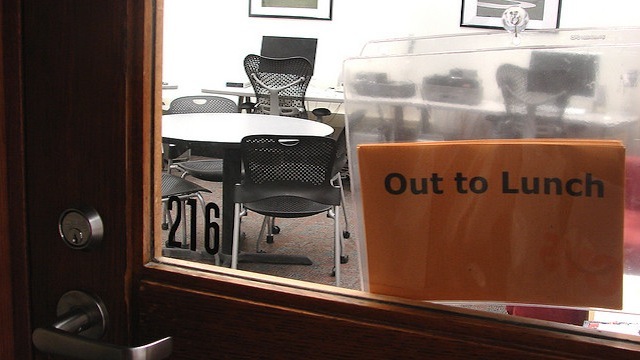Dear Lifehacker, I recently changed careers and now work from home for half the week. How do you plan your eating? Any meal or snack suggestions to keep my energy up and minimise chair flab? I don’t want to raid the fridge every time I get munchy, but I don’t have a lot of time to cook big breakfasts and lunches either. Sincerely, Hungry Hungry Home-Worker
Photos by Quinn Dombrowski, Nomadic Lass, and Ed Yourdon.
Dear Hungry HHW,
It’s trickier than it seems, isn’t it? Just because it’s tough to eat right on-the-go doesn’t mean that it isn’t challenging to stay healthy while working from home. To help us tackle the topic, we turned to our friends, nutritionists and registered dietitians Andy Bellatti and Alannah DiBona, both voices you’ve heard around here before championing the cause of smarter, healthier eating.
Like you mentioned, you don’t want to raid the fridge every time you feel a little hunger pang, and you don’t want to eat snacks and treats all day just because they’re easy to unwrap and put in your face. At the same time, working from home does mean actually working, so you may not have time to cook a lavish breakfast or a well-rounded lunch every day. Here are some tips to help you stay healthy and in shape when you have the whole kitchen just a few steps away.
Plan Around Your Own Willpower
Some days you’ll have the time to eat well. Other days you’ll be stressed and grab whatever you can unwrap. You should plan for both and give yourself plenty of healthy options for either case. The same way you might dress the part to discipline yourself while working at home, show the same discipline when it comes to food. Alannah explains that some of the tricks you would use if you were commuting work well at home too:
First: what do you like to eat that you know to be healthful and easy to prepare? Can some of the prep work be done ahead of time? Choose recipes, shop accordingly, prepare as much as possible and portion the finished product into tupperware, covered bowls or canning jars. Portioning your food ahead of time is important – an open cereal box or potato chip bag on the desk has an uncanny knack for emptying itself before day’s end! As always, it’s important to choose foods that you actually like. I can’t tell you how many of my clients try to damn themselves to a week of grilled chicken and broccoli for lunch when it doesn’t excite them in the slightest – if you’re not enthused by it from the get go, you’re far more likely to find yourself fantasising about a corner store burrito and a big gulp.
Andy agrees and pointed to a topic we’ve covered before: Your diet is only as good as the food you have around you. You can mean to eat well, but if your pantry is full of soft drinks and chips, you’re not going to get very far. He says:
Your choices can only be as healthful as your environment. If your kitchen is chock full of cookies, chips, ice cream and candy bars, you’re setting up a dietary minefield. Don’t keep highly processed “trigger foods” (ones you have a hard time staying away from) at home. Also, keep certain healthy snacks (nuts, fresh fruit) within eyesight, rather than stashed away. This way, you’ll be more likely to gravitate toward them.
It may sound like work, but meal planning doesn’t have to be stressful. It can even be fun, once you start thinking about what you might like to eat in advance. Just remember to give yourself room for cravings — part of what makes working from home different is that you usually can’t just put your planned lunch aside and go see “what the cafe is serving” or “go out to lunch with coworkers”, although you can certainly go out to lunch on your own. Still, you’ll save money (and eat healthier) if you account for those days with something healthy you can turn to easily.
Schedule Your Meals and Snacks

Working from home means you don’t have the general ebb and flow of the office to guide you. There’s no wave of coworkers all headed to lunch at the same time, and no one will come by your desk to ask you if you want to grab a bite. It can be freeing, but that same freedom can lead to random eating and snacking without paying attention to when you last ate and when you plan to eat next.
Put your meals and snacks on your calendar, the same way you would for meetings and conference calls. Doing so makes you pay attention to when and how frequently you’re eating and gives you a way to see when your next snack is (so you don’t just get up and head to the kitchen whenever the mood strikes). Then, try not to eat while you’re working. Alannah explains:
Try not to eat while you’re working — set a small amount of time and step away from the computer. Extra points awarded if you can eat at the table without distractions. Chowing down in front of the monitor leads to a lot of food dissatisfaction, mostly due to the fact that you tend to overeat, or feel as though you’ve missed the best parts of your meal (you’ll find yourself only focusing on the last few bites, which tends to lead to wanting more).
Andy agrees, especially on the eating while working part. He notes that scheduling your meals and snacks accomplishes two things:
Set alarms on your computer to help you establish structured eating patterns. In the course of an 8-hour workday, I recommend two alarms for snacks (one in the morning, one in the afternoon) and one for lunch. This is not to say you *have* to eat two snacks, but these alarms can serve as an opportunity for you to stop, gauge your hunger level, and make an informed decision. Also, never snack while working. This sort of “mindless eating” can make it hard to gauge hunger levels and remain aware of how much you eat. When you take a snack break, take it away from your computer and your work. It’s important to separate “work time” from “meal time”.
We’ve talked about these exact techniques before: Programming your day, even to the extreme, can offer some structure that many of us really need, especially when working from home. Be flexible, but do it within a framework. That way you’ll avoid the temptation to snack randomly, and eat at your desk while you work. Eating at your desk makes you less productive at the office, why should it be any different at home?
Give Yourself Easy, Healthy Options

Don’t be fooled into thinking that because your kitchen is right downstairs that you’ll “figure something out” when you get hungry. If you don’t buy foods for breakfast and lunch, you’ll stare at an open fridge, wondering what you can eat without spending too much time away from your desk, and wind up eating poorly.
Buy things you like that are also good for you, but not so much you’ll get sick of any one thing for breakfast or lunch. Mix it up and give yourself plenty of options. For example, Andy suggests smoothies as a time-saving and healthy option for any meal:
If you’re under a tight deadline and only have 10 – 15 minutes for lunch, rely on homemade smoothies. Making your own homemade smoothies is much better than buying pre-made smoothies, which are mostly sugar bombs made with fruit purees and fruit juices.
Mix fresh/frozen fruit, the milk of your choice (dairy or plant-based), a healthy fat (i.e. nut/seed butter, nuts/seeds, coconut milk, avocado), and a high-fibre ‘add-on’ (i.e. oat bran, ground flax, chia seeds). You can also, optionally, add your protein powder of choice (don’t forget about mighty hemp protein) if you want to make it especially filling. This kind of smoothie will keep you satiated for several hours, is made from wholesome ingredients, and only takes minutes to make.
Have cut-up vegetables ready to go in the fridge so that, if you want to snack on celery and hummus, you already have washed and cut up celery ready to go in a Ziploc bag (this prevents you from thinking: “I don’t have time/don’t feel like washing celery and cutting it right now”).
Convenience is key, Andy notes. Whatever you prefer to eat, making sure you can grab it and eat will also make sure you don’t wind up reaching for something less healthy but also less effort. If you do have time to cook (and want to do it), go for it, but know you won’t want to cook all the time. Finally, remember working from home means never having to deal with leftovers — you’ll always have lunch for the next day.
Get Help When You Need It

Just because you don’t have coworkers to drag you out to lunch doesn’t mean you have to suffer in silence. Call a friend and have lunch together — either at your home or out somewhere. Lunch in the park is a great way to save a little cash (since you can bring your own food) and get outside for a little bit and enjoy the fresh air (which we know can make you more productive), with or without company.
Once you start building healthy habits, they’ll be easier to stick to. However, if you need help with them, don’t be afraid to reach out and get it. Alannah suggests you check to see if your company offers an EAP or a dietician you can schedule time to speak with. It may sound strange, but my last job offered a similar service. I had a nutritionist who gave me a ring every two to three months to offer guidance and see how I was doing with my diet and health goals. Beyond that, consider joining a health or fitness community online. Alannah explains they’re remarkably effective, provided you can find a good one:
A sense of community has proven very effective in helping people achieve their wellness goals. When working from home, willpower can only take a person so far. People looking to maintain or lose weight, or simply stick to an energising, wholesome eating pattern should consider experimenting with food tracking and building community. Both are available through a number of venues – simply using a free app such as LoseIt! can be effective. For an increased level of accountability, insight into eating habits and patterns, and guidance, I’d recommend hiring a remote coach for a monthly fee through a service like My Body Tutor.
If you’re looking for more options or communities to join, one of your favourite nutrition tracking sites.
When you work in an office, working from home may sound luxurious and stress free, with plenty of time for naps and meals. In reality, it’s not so simple. Working from home does offer some freedom you don’t have in an office, but that freedom and lack of structure can also lead to its own challenges and bad choices. Hopefully these suggestions will help you stay healthy now that you’ve ditched your commute. Just remember to get up from the computer once in a while!
Cheers
Lifehacker

Comments
One response to “Ask LH: How Can I Eat Healthier While Working From Home?”
Wow, guess different personality types, etc. When I worked from home full time, I ate the healthiest I ever have in my life. I was also the fittest. I’m desperate to get back to it actually…